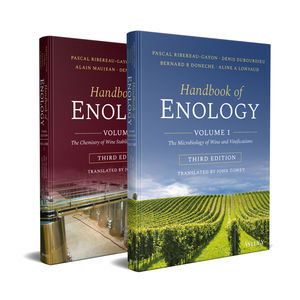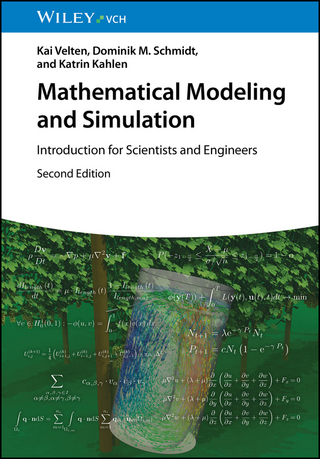
Handbook of Enology
Wiley-Blackwell (Verlag)
978-1-119-58766-8 (ISBN)
- Titel z.Zt. nicht lieferbar
- Versandkostenfrei innerhalb Deutschlands
- Auch auf Rechnung
- Verfügbarkeit in der Filiale vor Ort prüfen
- Artikel merken
This third English edition of The Handbook of Enology, is an enhanced translation from the 9th French 2017 edition, and is published as a two-volume set describing aspects of winemaking using a detailed, scientific approach. The authors, who are highly-respected enologists, examine winemaking processes, theorizing what constitutes a perfect technique and the proper combination of components necessary to produce a quality vintage. They also illustrate methodologies of common problems, revealing the mechanism behind the disorder, thus enabling a diagnosis and solution.
The Handbook describes winemaking in two phases:
Volume 1: The Microbiology of Wine and Vinifications addresses the first phase of winemaking to produce an »unfinished« wine: grading grape quality and maturation, yeast biology then adding it to the grape crush and monitoring its growth during vinification; and identifying and correcting undesired conditions, such as unbalanced lactic and acetic acid production, use of sulfur dioxide and alternatives, etc. Coverage includes: Wine microbiology; Yeasts; Yeast metabolism; The conditions for the development of yeasts; Lactic acid bacteria, their metabolism and their development in wine; Acetic bacteria; The use of sulfur dioxide in the treatment of musts and wines; Products and processes acting in addition to sulfur dioxide; Winemaking; The grape and its maturation; Harvesting and processing of grapes after harvest; Vinification in red and white wine making.
Volume 2: The Chemistry of Wine and Stabilization and Treatments looks at the wine itself in two parts. Part One analyzes the chemical makeup of wine, including organic acids, alcoholic, volatile and phenolic compounds, carbohydrates, and aromas. Part Two describes the procedures necessary to achieve a perfect wine: the clarification processes of fining, filtering and centrifuging, stabilization, and aging. Coverage includes: Wine chemistry; Organic acids; Alcohols and other volatile products; Carbohydrates; Dry extract and mineral matter; Nitrogen substances; Phenolic compounds; The aroma of grape varieties; The chemical nature, origin and consequences of the main organoleptic defects; Stabilization and treatment of wines; The chemical nature, origin and consequences of the main organoleptic defects; The concept of clarity and colloidal phenomena; Clarification and stabilization treatments; Clarification of wines by filtration and centrifugation; The stabilization of wines by physical processes; The aging of wines in vats and in barrels and aging phenomena.
The target audience includes advanced viticulture and enology students, professors and researchers, and practicing grape growers and vintners.
Volume 1
Foreword Preface to the Second Edition Preface to the First Edition Remarks Concerning the Expression of Certain Parameters of Must and Wine Composition Part I – Microbiology of Wine 1 Yeasts 2 Yeast Metabolism 3 Conditions of Yeast Development 4 Lactic Acid Bacteria 5 Metabolism of Lactic Acid Bacteria 6 Lactic Acid Bacteria Development in Wine 7 Acetic Acid Bacteria 8 The Use of Sulfur Dioxide in Must and Wine Treatment 9 Products and Methods Complementing the Effect of Sulfur Dioxide Part II – Vinification Reflections on Global Taste and Typicity of Wines 10 The Grape and its Maturation 11 Harvest and Pre-Fermentation Treatments 12 Red Winemaking 13 White Winemaking 14 Other Winemaking Methods
Foreword Preface to the Second Edition Preface to the First Edition Remarks Concerning the Expression of Certain Parameters of Must and Wine Composition Part I – Microbiology of Wine 1 Yeasts 2 Yeast Metabolism 3 Conditions of Yeast Development 4 Lactic Acid Bacteria 5 Metabolism of Lactic Acid Bacteria 6 Lactic Acid Bacteria Development in Wine 7 Acetic Acid Bacteria 8 The Use of Sulfur Dioxide in Must and Wine Treatment 9 Products and Methods Complementing the Effect of Sulfur Dioxide Part II – Vinification Reflections on Global Taste and Typicity of Wines 10 The Grape and its Maturation 11 Harvest and Pre-Fermentation Treatments 12 Red Winemaking 13 White Winemaking 14 Other Winemaking Methods
Volume 2
Part I – Chemistry of Wine 1 Organic Acids in Wine 2 Alcohols and Other Volatile Compounds 3 Carbohydrates 4 Dry Extract and Minerals 5 Nitrogen Compounds 6 Phenolic Compounds 7 Varietal Aroma Part II – Wine Stabilization and Treatments 8 Main Sensory Defects: Chemical Nature, Origins and Consequences 9 The Concept of Clarity and Colloidal Phenomena 10 Clarification and Stabilization Treatments: Fining Wine 11 Clarifying Wine by Filtration and Centrifugation 12 Stabilizing Wine by Physical and Physicochemical Processes 13 Aging Red Wines in Tanks and Barrels: Phenomena Occurring During Aging References Index
| Erscheinungsdatum | 23.04.2021 |
|---|---|
| Verlagsort | Hoboken |
| Sprache | englisch |
| Maße | 178 x 254 mm |
| Gewicht | 666 g |
| Einbandart | gebunden |
| Themenwelt | Naturwissenschaften ► Chemie |
| ISBN-10 | 1-119-58766-2 / 1119587662 |
| ISBN-13 | 978-1-119-58766-8 / 9781119587668 |
| Zustand | Neuware |
| Informationen gemäß Produktsicherheitsverordnung (GPSR) | |
| Haben Sie eine Frage zum Produkt? |
aus dem Bereich


